The Chest Muscles

SPORTS INJURIES TO CHEST MUSCLES
Sports related chest injuries are fairly uncommon, but it is important to keep in mind that life threatening situations can occur during high impact collisions with another player, or an object, either stationary or moving(usually blunt trauma as opposed to penetrating). The mechanism of injury, as always, must be considered on assessment, and symptoms should be monitored. A pulled chest muscle can feel similar to medical issues with the heart or lungs, with symptoms including dyspnoea, shock, haemoptysis, irregular pulse, decreased breath sounds, distended neck veins and tracheal deviation. It is imperative, therefore that such symptoms are assessed and monitored, and a doctor should be seen if any of the following apply:-
• Fast/ laboured breathing
• pain that gets worse with time/ doesn’t respond to pain medication
• severe pain or numbness that lasts more than 1 hour
• difficulty moving
• weakness or lethargy
• redness or inflammation of the affected area
• a "popping" sound when the injury occurs
THE INTERCOSTALS
The most common chest injury is a muscle strain due to overstretching or tearing of the muscle, which will cause sudden, sharp pain. This is generally a minor injury, however, usually healing within days or weeks. The intercostal muscles which sit between the ribs are the most commonly affected.They stabilise the rib cage and assist with breathing.
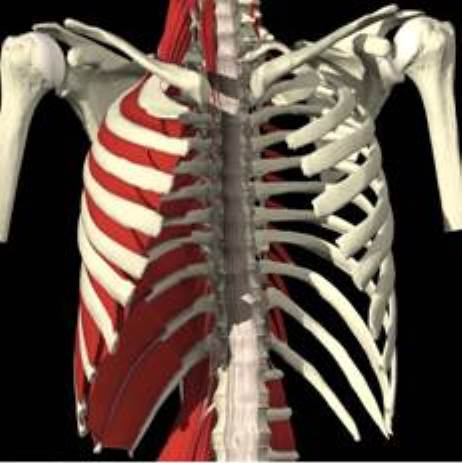
CAUSES
• Heavy lifting due to sport or occupation
• sports injuries from overstretching, muscle fatigue, or repetitive and forceful movements
• contact injuries
• insufficient warmup before exercise
• poor flexibility
• twisting the torso beyond its normal range
• reaching overhead for extended periods
• overuse of the muscles
• chronic poor posture
• falling
• severe persistent coughing
SYMPTOMS
• increased pain with movement of the chest or upper spine • pain gets worse with deep breathing, coughing, sneezing
• tenderness within the chest wall
• upper back pain
Muscle strain is graded according to severity:-
GRADE 1 (mild damage): less than 5% of individual muscle fibres are damaged, with minimalloss of strength and movement. Recovery usually takes between 2 and 3 weeks.
GRADE 2 (moderate damage): more of the individual muscle fibres are damaged, but the muscle is only partially torn, resulting in significant loss of strength and movement. The injury may take 2 - 3 months to heal fully.
GRADE 3 (complete tear of the muscle):sometimes surgery may be required to reattach the damaged muscle.
TREATMENT AND RECOVERY
Treatment depends on the severity or grade of the injury involve a combination of the following:-
• Rest - Avoid strenuous activity to help aid recovery
• Ice - apply ice pack to the affected area for up to 20 minutes several times a day
• Compression - Wrap a compression bandage around the torso
• Elevation - sit upright and use extra pillows when sleeping to keep the chest elevated The RICE principle should be used 24–48 hours following the injury.
• Pain/anti-inflammatory medication eg ibuprofen (in more severe cases muscle relaxants can be prescribed)
• cough medicine if the strain is due to a persistent cough
• Surgery – if the muscle strain is a grade
3.THE PECTORALS
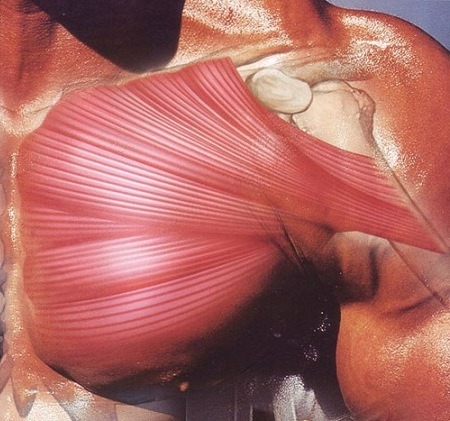
The pectoralis major muscle is a large muscle at the front of the chest which:-
• rotates the arm inwards
• pulls the arm across the body (adduction)
• pulls the arm downwards from above the head(flexion into extension)
• pulls the arm upwards from the side(abduction)
The tendon attachment to the arm bone is a weak spot, prone to strains causing pain and inflammation around the front of the shoulder, sometimes with a visible change in appearance. This type of strain is more common in weight training, especially when performing a bench press.
SYMPTOMS
• sudden sharp pain at the front of the upper arm near the shoulder
• rapid swelling of the front of the shoulder and upper arm
• pain gets worsen when the arm is pulled across the front of the chest or rotated inwards against resistance
• there may be a visible gap or lump in the muscle if the pectoralis ruptures
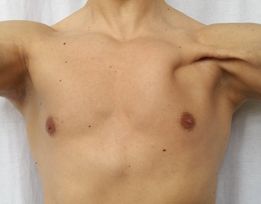
TREATMENT
Treatment is the same as with the intercostal muscle strain (part 2). R.I.C.E. (rest, ice, compression, elevation) for 48 hours following injury. Ice can be applied for 10 to 15 minutes every hour initially decreasing as symptoms reduce. A grade 3 tear of the tendon will probably require surgery. Sports massage can be introduced after a long rest period when inflammation has subsided.
STRETCHES
These stretches for the pectoralis major can either be used as a preventive measure or to rebuild strength and flexibility following the acute stage of injury.
• Behind the Head stretch
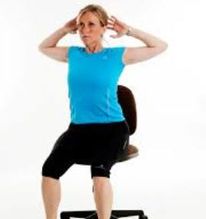
– this stretch works the pectoralis major and minor. Stand straight up with your feet close together, your arms bent so your palms are resting against the back of your head. In a slow and controlled motion, push your elbows back as far as you can until you feel a light tension in your shoulders and chest. Return to your starting position.
• Doorway stretch
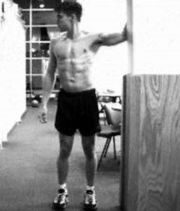
- Stand in a doorway, the forearm of one arm resting against the side, your other arm straight down at your side. While maintaining contact of your arm to the side of the doorway, gently turn your body away from that arm. You should feel a light stretching in one side of your chest. Repeat and then switch sides.
